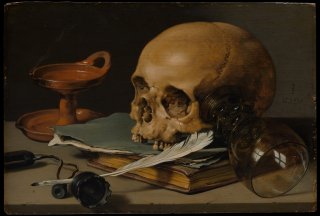
This piece is the intersection of European tradition, chinese collecting, and chaekgeori painting. This piece was create by Giuseppe Castiglione, the court painter of China for several decades. While this piece resembles a chaekgeori screen, in reality, it is a painting of a Chinese duobaoge, a cabinet used to display items in wealthy Chinese households. The European linear perspective that inspired Korean chaekgeori is on full display within the trompe l'oeil shelves, and the wide array of pieces makes clear the broad sweeping collecting practices of China. Many items held in common with Korea are seen, such as the many books, the mixture of ceramics and metalwork, and the Buddha’s hand fruit in the center. Most notably, in the top left niche, a fluted metal piece with many small rings on it is in clear view. This is incredibly reminiscent of the Korean Bronze Age ritual objects. This is a physical reminder of the constant exchange of culture and objects between these two regions, and this painting further showcases this pathway of communication.




